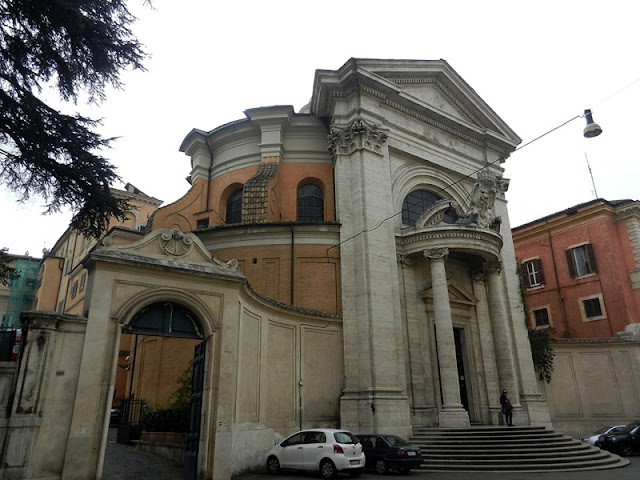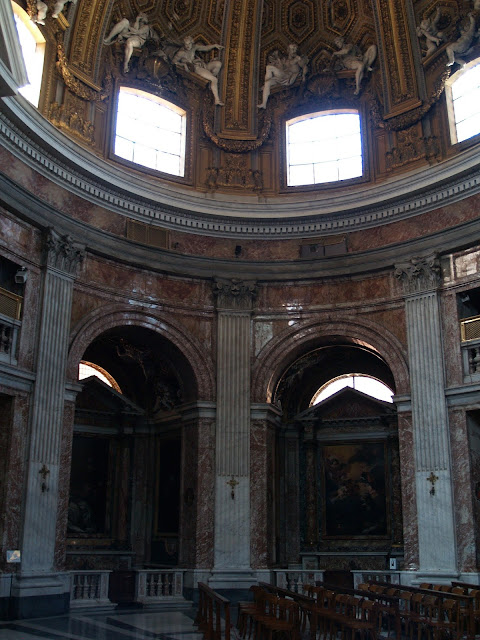This church uses the round and curved forms of high Baroque design masterfully, as fine as the most singular buildings by Bernini's rival Francesco Borromini. Borromini's dramatic and eccentric buildings began in Gothic number symbolism. Borromini began as a stonemason in a remote part of what is now Switzerland working in the Gothic style still prevalent in many parts of northern Europe.
The curving forms in Bernini's church begin in drama, in presenting a story dramatically. In this case, it's the story of the death and triumph of a religious martyr, St. Andrew.
Unlike so many of Rome's major churches, Sant' Andrea al Quirinale does not sit at the end of an avenue or street, nor does it face a piazza. It sits off to one side of the street.
A Google Maps view of the Via del Quirinale. Sant' Andrea al Quirinale is on the left.
Bernini's early experience in theatrical set design gave him an understanding of how to direct people's attention. The dramatically curved entrance of the church simultaneously sets it back from the street while projecting the main entrance forward. The concave walls flanking the church facade accomplish the same end as the oval colonnades of St. Peter's Square, they direct our attention to the church entrance.
The church entrance projects forward in a dramatic circular porch that inverts the the curve of the apse inside. While the apse recedes from us, the entrance portico projects forward and opens up at the same time. The circle of the portico entablature forms part of the main entablature that runs all around the exterior and interior of the church. The entablature and the curved steps reflect the arch of the window in the entrance, seeming to project forward from the heavy temple-inspired facade. All of this design bids us to come in and see the drama inside.
The dome is much lighter, lit not only by an oculus in the top, but a row of clerestory windows of varying size above the entablature around the springing point of the dome. The difference in lighting and the large unbroken entablature around the interior establishes two zones that suggests the contrast between earthly and heavenly realms. Below the entablature is the fatal horror of St. Andrew's crucifixion. Above the entablature is his triumphant arrival in heaven.
A hidden window in a smaller cupola lights up the painted altarpiece of Andrew's crucifixion painted by Borgogne (Guillaume Courtois) a French painter working in Rome employed by Bernini on occasion (his Italian nickname means "The Burgundian"). Another frequent Bernini employee, the sculptor Antonio Raggi carved all the stucco figures in the church including the gilded stucco assembly of angels who seem to hold the painting for our instruction.
The smaller apse cupola with Antonio Raggi's swarm of descending angels.
One of Raggi's angels descends with the crown of martyrdom.
On my one and only visit to this church in 1988, I noted a couple of things. First, it is a very desirable location for weddings. They were setting up for a wedding as I visited.
Bernini kept the long ends of the oval from distracting our attention by terminating each of them with a large pilaster instead of another chapel.
The focal point of the whole drama is not the altar but the sculpture of St. Andrew ascending into heaven above the entrance to the apse. The architectural setting directs our attention straight to him as the dramatic center of the whole ensemble. The apse pediment curves inward, opening a space for him.
Bernini uses screening columns to set the apse apart from the rest of the church, a device Palladio used in his Venetian churches. Bernini uses the apse as a theatrical stage to set the drama of the saint's death and resurrection and to identify it with the mystery of death and resurrection acted out upon the altar. The columns play a role similar to a parting curtain revealing the drama and mystery at the heart of this church.
Borgognone's painting of the Crucifixion of St. Andrew.
Saint Andrew rising into heaven.
Bernini takes the great coffered dome of the Pantheon and turns it into a vision of the Christian heaven. As in so many Baroque churches, heaven seems to come down to earth to meet us, sometimes breaking through the ceilings or the walls to do so. The line between art and life is stretched but never broken. Illusionism and spectacle appeal to our emotions, astonishing us and taking our breath away. For true believers in Roman Catholic Doctrine, these spectacles were even more meaningful. They were meant to confirm and encourage people of the rightness of their faith. These spectacles were ultimately for the members, not for outsiders.
There is such a spectacle here in this church, but it is more oblique than the later Baroque ceiling spectaculars painted by Gaulli and Pozzo. The abstract forms of the architecture fully participate in the drama here, and not just as setting. The architecture doesn't break so much as open up to let us see the drama and let the heavens into the church.
The drama of Andrew's triumphant entry into heaven told in imagery and architecture in the dome.
Antonio Raggi carved stucco figures of fishermen with their nets around the base of the dome. They greet a fellow member of their trade into the here-after.
One of the best details from the carved stucco work, putti playing among the garlands on the dome.
The oculus of the dome with the Dove of the Holy Spirit at the apex. More putti descend like bubbles into the interior of the church. Bernini together with Raggi create the impression that all of this is happening in the here and now right in front of us.
The tomb of St. Stanislaus Kostka
Second, I noted a large number of Polish visitors. It turns out that very important Polish saint is buried here, St. Stanislaus Kostka. Stanislaus was a very young novice in the Jesuit Order. He became a novice on his seventeenth birthday. He died not long after of a fever, supposedly after foretelling his own death.
His piety and faithfulness made him a very popular saint in Poland and among the Polish diaspora.
A painting by Giovanni Odazzi in Sant' Andrea al Quirinale of St. Stanislaus Kostka triumphantly rising into heaven from the early 18th century.
The church of St. Stanislaus Kostka a few blocks from where I live in Brooklyn.






















No comments:
Post a Comment